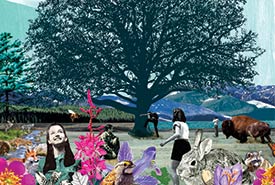The future before us

Collage of animals, plants and people in nature (Art by Tara Hardy)
Youth have become an unrelenting force in their mission to use their voices to safeguard biodiversity and the environment
By Jenn Thornhill Verma, freelance journalist and artist
Rebekah Neufeld talks about the bur oak trees that backdrop her family’s Ninette, Manitoba, farm like she knows them. They have always provided, says Neufeld, whether as a source of recreation for climbing or a source of firewood for heat. Now 32 years old and with a decade of working for the Nature Conservancy of Canada (NCC), currently as he acting conservation science manager for the Manitoba Region, Neufeld appreciates the oak trees for their persistence, too.
“Bur oaks will grow on dry, hot, rocky or sandy habitats as short, gnarled survivors; they flourish in thick forests along river valleys and floodplains; or they grow tall with spreading branches in open prairies, where they can survive prairie fires and harsh winters,” says Neufeld, “Nature is home. It’s fun. It’s sustenance and protection. It’s part of who I am, and yet it’s a giant, fascinating mystery.”
Exuding youthful energy and enthusiasm, Neufeld lights up when she talks about nature and ways to protect Canada’s most precious natural places. She’s in good company at NCC, where 40 per cent of the staff is younger than 35. Globally, youth have become an unrelenting force (one might say like a bur oak) in their mission to use their voices and share their values to safeguard biodiversity and the environment.
Looking ahead
A strong workforce of young adults (those aged 18–35) is a strategic advantage because it helps us focus on tomorrow, take bolder actions, think innovatively and consider long-term impacts, says NCC’s president and CEO, Catherine Grenier. “When you have a young cohort working with you, it allows you to glance at what the future’s going to look like,” says Grenier. “In the nature conservation field, it’s important to have all demographics represented, but especially young adults, because they’re the ones who will see the benefits of the work we are doing now in five, 10, 15, 25 years.”
If you look back at NCC’s big accomplishments from the last while, there have been young people involved in almost every one,” says Megan Lafferty, NCC’s manager of land protection measures. “For example, young staff led the Vidal Bay project, our largest to date in Ontario. From fundraising to closing projects, many young staff were instrumental in the success of our Landmark Campaign. And they are pushing us to do more, better.”
Lafferty has joined Grenier for today’s interview about young people leading the way in conservation. The joint interview is a subtle, but important, signal that shows NCC’s youthful advantage is not by accident, but by design. Lafferty, 32, heads up a taskforce of young staff entrusted with making recommendations to NCC’s management, using the “by youth, for youth” approach, well-understood as a prerequisite formeaningful youth engagement. Young people know what young people need, Lafferty says, and when they lead with a clear purpose, it injects their fresh perspectives and unique values into conservation efforts.
“Young people today think more about social impact and take a more comprehensive look at their actions and their consequences, as well as the interconnectedness of the things we do,” says Lafferty, “We’re seeing more and more how interconnected the challenges we’re facing are with climate change and biodiversity. Supporting young people who have that interconnected vision is important if we want to address those challenges.” Added to that, Lafferty says, is that today’s youth leaders are tomorrow’s world leaders.
“In the climate and biodiversity space, youth are not tomorrow’s leaders, they’re the only leaders,” challenges James Bartram, resident of the Canadian Committee for the International Union for Conservation of Nature (CCIUCN). It’s a bold statement from someone who is a strong supporter of intergenerational learning, where people of all ages learn together and from one another. But Bartram’s statement is not meant to undermine the contributions of previous generations. Instead, he credits young people for having mainstreamed climate change in global conversations, and says the same will only happen for biodiversity if youth are educated, equipped and empowered to lead. To help young adults advance their conservation leadership, CCIUCN has for many years hosted a Youth Ambassador Program, while their Young Professionals in Canadian Conservation Network is a one-thousand-member-and-growing inclusive virtual network raising up the voices of young conservation leaders.
This is an excerpt of a story that first appeared in the winter 2022 issue of the Nature Conservancy of Canada Magazine. Donors who contribute at least $25 or more per year will receive the magazine. Click here to donate today and start receiving the magazine.
Explore additional content from our winter issue here >



